Saturday, May 14, 2011
PRAWN OR SHIRMP?
 Is there a vast difference between the two? These are some question which might cross your mind when you ponder over buying some of these delicacies from the local fish market or while ordering an appetizing sound dish to accompany your main course. Well look no further because we have the answer right here.
Is there a vast difference between the two? These are some question which might cross your mind when you ponder over buying some of these delicacies from the local fish market or while ordering an appetizing sound dish to accompany your main course. Well look no further because we have the answer right here. Another difference is found in the way the two brood their eggs. A prawn has longer legs than the shrimp and a shrimp’s front pair of pincers is larger, whilst a prawn’s second pair of pincers is bigger. Both species belong to the same family as crabs and lobsters, Decapod crustaceans which mean that they possess 10 legs and a hard shell to cover their body. The confusion arises because both varieties are somewhat similar in size and looks.
Saturday, May 07, 2011
Thinking of the future…
When I look back at the past all I can see is a perfectly crafted forward integration strategy, by two gentlemen who were passionate in business. Even though they haven’t known about all these business jargon which we learn today they have used it to perfection almost two decades back without getting consultancy of any guru’s in strategy.
Mr. Hisashi Yanase
Days pass by… May father build an empire
If I were to look back at the past if this meeting wouldn’t have happened, things would have been quite different. Thus I feel it is important that I spend some time on explaining about who Mr. Yanase is and how this meeting occurred…
Facts about me & who I am?
 When I was glancing through the blog it suddenly clicked my mind that I should published the legendary story of our family business which my father created. Some might argue that ‘legendary’ is not the most appropriate word, but for me it seems as the more ideal since no one other than who is gifted with some special power would be able to build such a business in quite a succession.
When I was glancing through the blog it suddenly clicked my mind that I should published the legendary story of our family business which my father created. Some might argue that ‘legendary’ is not the most appropriate word, but for me it seems as the more ideal since no one other than who is gifted with some special power would be able to build such a business in quite a succession.Saturday, October 03, 2009
Think positively! Good chance to invest in...
There are many reasons for me to tell like that,
The readers should bear with me for only concentrating on the deamand created for the processing factories from the above mentioned scenario since I am only concentrating on the investment potential.
As I mentioned in my last post as well, there would be a great influx of seafood to Colombo from N&E as soon as the A9 is open.
On the other hand most of the processing factories currently uses about 50-60% of their operational capasity using the current supply from the rest of the country. One million dollar question would be whether Colombo based processing factories have the capasity to entertain the large influx from N&E. Here I do not necessarily mean that all the current processing factory owners should look at increasing their current operational capasity or build new facilities aiming at the influx. But mind you, there are quite a number of people who have already started the negotiations to set up new facilities. Many more are looking forward to enter into the industry.
There is another perspective to the problem in concern. Rather than trying to bring down the N&E catch to Colombo, if someone take the initiative and sets up factories in the Nothern part of the country to cater for the N&E catch then it would also have a lot of positives. It would create a lot of job oppertunities to the unemployed youth, it would reduce the spoilage during transportation and allows the development of the seafood industry as a value adding cluster in the Northern part of the country.
Many would not know that Nothern part of the country had more than a dozen seafood processing factories before the seperatist war broke out. They processed the seafood catch of N&E. The breaking out of the war saw the closing down of all those factories which operated in the North. Then only in the late 80's we saw the setting up of processing factories in the Western province.
Also when processing factories were in operation in the early 80's South India did not have more than one or two factories which specialised in seafood exports. But after the war broke out seafood processing factories mashroomed in South India. This is an indication how India benefited due to the war of Sri Lanka.
I heard from very informed sources that currently there are few seafood processing factories being constructed in Trincomalee in the Eastern part of the country. Also there is news that many cold storage facilities are being constructed in the North. Further government is in the verge of supplying the needed fishing gear to uplift the profession of the fishermen in the North. Thus we can be assured that we are going to get a good time in the coming years.
On the demand side the world demand for seafood have been on the increase for the last few decades. If Sri Lanka generates quality seafood the potential would be immense.
Due to that I hope this is the right time for the investors to look at seafood industry as a lucrative investment for the future. many established organizations have identified the potential and are making arrangements to conquer the North.
The first mover would always have an advantage as in all other cases....
Back to the good old days!
Couple of months back we witnessed the end to the seperatist war which ran for more than 2 dacades. The coastal belt in the N&E which was not open for fishing for many years have now been open again for the local fishermen.
The N&E breeding grounds which have not been fished for nearly 2 decades would be full of resources, and Sri Lankan fishermen can be sure of getting a good income for their living in the comming months.
Eventhough fishing restrictions in the N&E have been taken off, still the A9 is not fully open. Thus we still have a problem in getting the fish catch down to Colombo. But we can be assured that it would not be long for us to see huge seafood quantities arriving in Colombo from N&E as soon as the A9 is open.
Also in the last couple of years the trend in Sri Lankan seafood exports also have changed drastically. Initially Sri Lanka exported large volumes of Shrimps. Now with the global demand shifting towards Tuna, Sri Lankan too have ventured into tuna exports.
There are quite a few processing factory owners currently who have mastered the art of tuna exports to EU countries in the last couple of years. And there are many more who are catching up the art of tuna loining very fast. Thus we see a very good trend in the development of tuna exports in Sri Lanka.
Sunday, January 01, 2006
Industrial Visit At The Sea Food Processing Factory
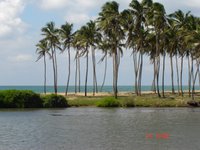 Last Saturday on the 31st of December few of the batch mates made a tour to the factory of my father. It was full of fun and excitement and for me too was a great experience. All got a through understanding of the operations process which takes place in the factory. Most of them were amazed to see the effort put into it for processing and the processes used in order to market the products in the European markets. It is much more than just sending sea food to a foreign country in a
Last Saturday on the 31st of December few of the batch mates made a tour to the factory of my father. It was full of fun and excitement and for me too was a great experience. All got a through understanding of the operations process which takes place in the factory. Most of them were amazed to see the effort put into it for processing and the processes used in order to market the products in the European markets. It is much more than just sending sea food to a foreign country in a 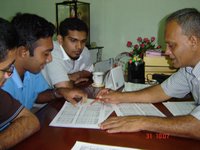 container.
container. All got the rare opportunity of observing the almost all the stages of the entire operations process starting from the purchasing of the materials from the suppliers, unloading, weighing and categorising depending on the weight, cleaning, putting, arranging, freezing, loading for the shipment.
Later in the day all went to the farm of us which is located some kilometres down to Puttlam road and got an insight about the aqua cultu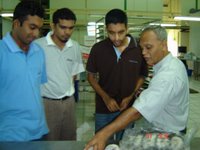 ring. I think all were amazed to see how technical it is and how hard it would be to manage a farm which spans across many acres with utmost care whilst ensuring the quality of an array of measurements needed to the development of healthy prawns.
ring. I think all were amazed to see how technical it is and how hard it would be to manage a farm which spans across many acres with utmost care whilst ensuring the quality of an array of measurements needed to the development of healthy prawns.
They got one of the rarest opportunities one would get, which is to get inside a hatchery where the breeding takes place and to see how it all happens. Even for me one of the great experiences was to see a mother prawn weighing 320g which had produced more than 45,000 babies. We visited the ponds where the prawn develops into the mature stage and all got a briefing from the Chief Quality Supervisor about the entire process.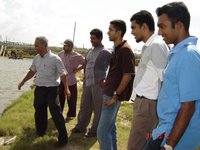
At the end the back at the factory all had a friendly discussion as to how the marketing aspect happen for the exported sea food from Sri Lanka and the developments in the international sea food markets.
At the end of the day I feel very happy about the outing and I think all who visited would have also felt the same apart from the vast amount experience all gained during the visit.
Tuesday, December 27, 2005
Increasing Demand for Sea Food in the World Market
 The trend in the world for the last few decades was to move back to the natural products; organic products, hybrid cars, etc... And the sea food in most parts of the world could be identified as one of the most preferred choices of the people who prefer the natural products. There is a belief in most of them that the fish products give the best nourishment in all the meat products which we consume.
The trend in the world for the last few decades was to move back to the natural products; organic products, hybrid cars, etc... And the sea food in most parts of the world could be identified as one of the most preferred choices of the people who prefer the natural products. There is a belief in most of them that the fish products give the best nourishment in all the meat products which we consume. Especially in the main markets for Sri Lankan sea food industry the demand trend for the last decade or so was quite fascinating. Out of the three main markets namely;
The main competitive advantage of  for the sea food industry in
for the sea food industry in
Especially it’s important for the country to have a long term vision for the development of the sea food business which has a similar potential as tourism. If I bring to you one good example the potential of it is, before the war erupted in
Due to the fact that there would be a huge demand from those markets of the developed countries for ‘ready to eat sea food products’ which would outclass the traditional shelf bought cook, fried or battered sea food products. The country should seriously think of some way to take the maximum use of the existing competitive advantages to good use and develop a firm range of value added and branded products of some nature to meet the world demand in another 10 years time.
Sri Lankan Sea Food Suppliers
 The sea food industry of
The sea food industry of There are the small fish sellers all around the country. And there are these sellers such as the ‘Fresh Fish’ who are selling to a much higher target group with an extensive range of outlets in
Apart from that there are many exporters who exports sea food based products to the International market. There are around ten major suppliers of the processed sea food to the European, Japanese and the USA markets such as the Agro Marine, Alpex Marine, Secco and Indiwary Aqua to name a few. These suppliers process the sea food in factories mainly situated in the  hilst the other sea food exports such as lobsters, crab shells, octopus, shark fins also brings a substantial amount of foreign income to the country.
hilst the other sea food exports such as lobsters, crab shells, octopus, shark fins also brings a substantial amount of foreign income to the country.
Few years back Sri Lankan suppliers used to produce the fish and by farming specially designed for the breeding of the prawns for the international market but the White Spot Disease which affected the entire prawn farming nearly flattened the industry. But due to the determination of the businessmen who were involved in the industry they were able to find out other means and survive in the market. Now this could be identified as a prime source of income generator to the country in the years to come.
History of Sea food processing in Sri Lanka

At the earliest stages very few businessmen exported sea food to the foreign countries. They directly purchased the sea food from the sea mongers and sent them abroad in iced packs without doing any processing. But since there is a good environment for fishing in
Normally the fish needs a shallow sea. The rock beds which spans across the North and Eastern costal belt provides the shelter for the small fish to breed well. And the salt composition of the sea in that area is also at the best level for fish. Due to those factors the costal belt of  hing exports few companies set up their plants in the
hing exports few companies set up their plants in the
And then big multinationals operating in the country such as Unilever and Carson Cumberbatch the concept of Aquaculture was bought to
But now slowly but steadily the industry is growing again and now it heavily depends on the sea catch once more again. And the high variety of sea food products has given the exporters to minimize their risk of investment because during the periods of low supply of certain varieties they can always depend on the other varieties.
Now the sea food processing have developed to a stage where the exporters always try to do some value addition and market their products to a higher segment of the market always which could be seen as a positive improvement for the future of the industry in Sri Lanka. But the ultimate realization of the industry would be to produce the high end products such as the ‘Ready To Eat sea food products’ to the EU counties, but there is a long way to go to achieve this position. But if the industry improves on like this and the governments gives the proper attention to the industry the future is very bright.
the exporters always try to do some value addition and market their products to a higher segment of the market always which could be seen as a positive improvement for the future of the industry in Sri Lanka. But the ultimate realization of the industry would be to produce the high end products such as the ‘Ready To Eat sea food products’ to the EU counties, but there is a long way to go to achieve this position. But if the industry improves on like this and the governments gives the proper attention to the industry the future is very bright.
White Spot Disease

For most of you who are not familiar to the topic of Aqua Culture Industry this would sound as an unfamiliar term, but for the one’s engage in the industry this would be a term which bring back some horrible memories. To be straight forward this is the diseases that made a big lost and damaged to the shrimp culturing industry which brought lot of foreign exchange to the county as well as kept remain 80% of net profit within the country of its exports. Many countries which exported in volume base in South Asian Region such as
The early 90’s was the period where the prawn farming came to the climax for anyone looking at it at a glance would be seen as a mine of gold.  During this period a few major exporters dominated the marketplace and earned huge amount of profits. During this period more than 4000 acres of land were used for the aquaculture. Almost all the lands which was suitable for prawn faming was utilised at this stage. But with the government change in the year of 1994 the supporters of the newly elected government by force acquired the reservation lands and started to do the farming. Due to this factor within one year the land used for farming skyrocketed to 12000 acres. And the hatcheries used to produce the baby prawns mushroomed from 4 to more than 100. But sufficient qualified personnel needed for the maintenance of these hatcheries were not to be found in
During this period a few major exporters dominated the marketplace and earned huge amount of profits. During this period more than 4000 acres of land were used for the aquaculture. Almost all the lands which was suitable for prawn faming was utilised at this stage. But with the government change in the year of 1994 the supporters of the newly elected government by force acquired the reservation lands and started to do the farming. Due to this factor within one year the land used for farming skyrocketed to 12000 acres. And the hatcheries used to produce the baby prawns mushroomed from 4 to more than 100. But sufficient qualified personnel needed for the maintenance of these hatcheries were not to be found in 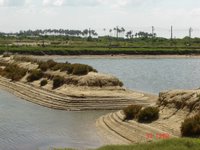 low tide of the sea. But due to the excess land capacity the water systems started to malfunction and the polluted water got stagnated in many of the prawn farms giving the chance for diseases to generate and kill the prawns. At the end the disease affected the whole
low tide of the sea. But due to the excess land capacity the water systems started to malfunction and the polluted water got stagnated in many of the prawn farms giving the chance for diseases to generate and kill the prawns. At the end the disease affected the whole
The blame of this devastation could be finger pointed directly at the government which was so inefficient both pre & post to the disease. Normally for a business of this nature the quality standards plays as the fundamental theme for success. But when the new suppliers mushroomed the government did very little checking into the quality standards of them both at the start up stage and when they are moving on with the operation. But at the end due to the determination of few of the original suppliers still the industry is running and showing signs of the good days again with the continues demand increase in the last few years.
So by now onwards at least if the government can look forward and get their acts together and give the best support to the industries as these which has a very high growth potential Sri Lanka would develop to a much higher state.
Current State of the Sea Food Exports of Sri Lanka.

Sea food exports comprises of many suppliers in
Even though the exports of Sri Lanka generates good amount of i ncome to the country there are a lot of other areas to which the country can specialize in such as the value added products specially to the up market client-tele in the European counties. The other countries specialize in this trade are the countries such as
ncome to the country there are a lot of other areas to which the country can specialize in such as the value added products specially to the up market client-tele in the European counties. The other countries specialize in this trade are the countries such as 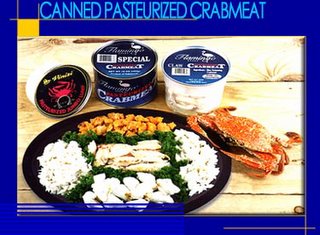
Thursday, December 22, 2005
Thursday, December 15, 2005
Sea Food Processing for International Market in SriLanka !!!
Here in Sri Lanka, there are some major exporters which do involve in exporting processed frozan and packed sea food items according to the buyers requirments in many part of the world. We do exports mainly to Japan, USA , Europe and Midle East markets.
Indiwary Aqua (Pvt) Ltd is one of the largest exporters of Processed sea food ( Shrimps, Cut Crab) to Japan and USA in Sri Lanka.
Company Information
The Company : Indiwary Aqua (Pvt) Ltd.
Legal Form : A private limited company in corporation in Sri Lanka under the companies Act No 17 of 1982 in 1992 as a private limited company.
Company Registation No :
Principal Place of Business : St. Martin Industrial Park
Bangadeniya, Chilaw,
Sri Lanka.
Tel : 0773159009
E-mail : indiwary19@yahoo.com; vajirasf@gmail.com
Blog Site : www.seafoodexports.blogspot.com
Marketing Division
Product Range :
Headless sea caught flower
















